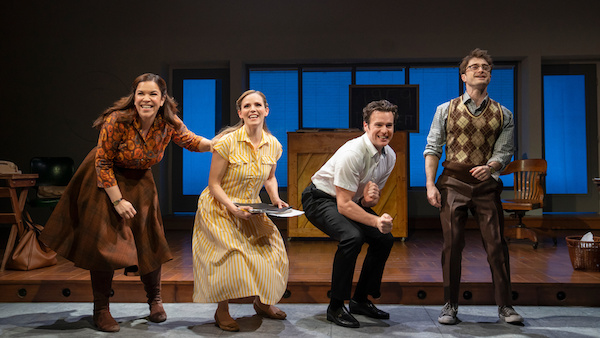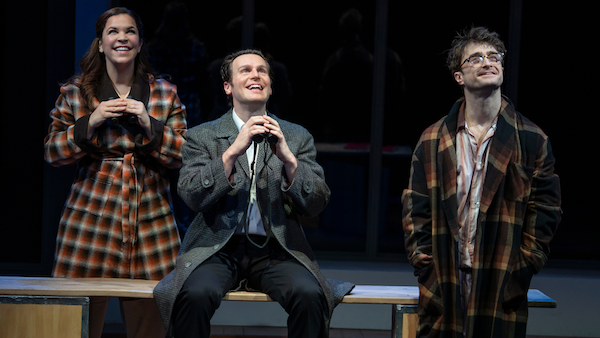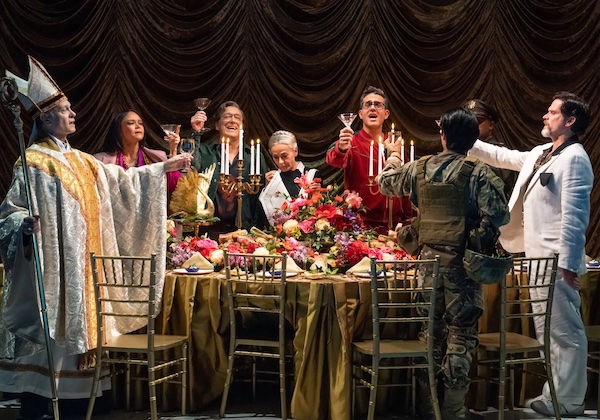Theater Reviews: Smash Broadway Revival of Sondheim’s “Merrily We Roll Along” and the Debut of His Final Show, “Here We Are”
By Christopher Caggiano
A Stephen Sondheim flop returns in triumph, while his final show tantalizes with what could have been.

A scene from the Broadway production of Merrily We Roll Along. Photo: Joan Marcus
Merrily We Roll Along is iconic in the hearts and minds of musical theater aficionados. When the original cast recording came out in 1981, shortly after the show had closed after only 16 performances, people wondered how a show with a score this good, with lyrics this smart, could possibly have failed.
But, as those who actually saw the original production of Merrily can attest, the live show was a disaster. Yes, Stephen Sondheim’s score was rich and full of character, but George Furth’s book was leaden and unfocused, and director Hal Prince made a concatenation of terrible decisions in a doomed effort to salvage the show during previews.
Unlike most prior Broadway musicals, Merrily We Roll Along did not have an out-of-town tryout, and this was just before nonprofit theater companies became a major force in developing new musicals. So, the show opened cold in New York. During previews, audience members were walking out in droves, and word quickly got around that the show was in deep, deep trouble.
In the years since, there have been numerous attempts to resurrect Merrily, based primarily on the cult status of the composer’s score. The show was reworked considerably; Sondheim added a good deal of material. (More on this later.) Over the years, various productions of a revamped Merrily were rumored to be headed toward Broadway, but only now, 42 years later, has the show finally made it back to the Great White Way.
And the results are positively triumphant. Not only is the production itself a triumph, but the staging is one of the best-selling shows on Broadway right now, playing regularly to capacity and bringing in nearly $2 million a week.
It is, of course, a tremendous shame that the late Stephen Sondheim isn’t here to enjoy the success of this production. (Read our Sondheim appreciation here.) He did, however, live to see the brilliance of director Maria Friedman’s production in its 2013 London incarnation and in its Boston run in 2017.
As most diehard Sondheimians know, Merrily We Roll Along centers around three friends: composer Franklin Shepherd, lyricist and playwright Charlie Kringas, and novelist Mary Flynn. The show famously goes back in time, which was one of the many things that turned audiences off in 1981. But when you are given a great production of the show like this one, you see that the device is not only genius but essential to its artistic achievement. We start at the dissolution of their longtime friendships and travel back to see how it all happened. Along the way we experience what almost seems like an overdose of dramatic irony: upon each milestone, we positively ache with the knowledge of the train wreck that will befall.
As mentioned earlier, Sondheim reworked the score considerably over the years; most of the additions are serviceable but mismatched. For example, during the “Growing Up” sequence, Frank sits at his piano and ponders the choice ahead of him: friendship or infidelity. Sondheim repeats numerous leitmotifs from the score, but the new music doesn’t match the traditional musical theater style of the rest of the show. At this point, Sondheim was writing in the soft, fragmented, arpeggiated style of his scores with James Lapine rather than the jazz chords and edgy rhythms of his work with Hal Prince. Fortunately, the rest of the score is still such a knockout that it’s easy to forgive the lackluster nature of the new material.

A scene from the Broadway production of Merrily We Roll Along. Photo: Joan Marcus
The enormous success of the current production is largely due to Friedman’s sensitive direction. Previous productions of Merrily failed to manifest the depth of the show’s characters and relationships. In this nuanced staging, the dimensions of each character feel deeply realized, the cracks in each relationship achingly exposed.
Another notable aspect of Friedman’s direction is her small staging touches that speak volumes. There’s the wordless scene in act two when we see Frank make his decision about whether he’s going to stay with Gussie or go to dinner with Charlie and Mary. As Frank is standing at the piano, he goes over to the phone and takes it off the hook. Then he starts to unbutton his shirt and heads upstairs to join Gussie. It’s a deeply compelling example of showing versus telling, and it’s one of the many moments that make Frank real.
And the point is that doing Merrily successfully is all about making Frank real. In most of the other productions I have seen, Frank is passive, a cipher. Things happen to him, but you’re not entirely sure why he allows them to happen. In Friedman’s hands — and Jonathan Groff’s — Frank makes his own decisions. You may not agree with his choices, but you understand why he’s making them. Groff brings a tremendous vulnerability to the role, showing us the weaknesses that lead Frank astray, but also a tremendous charm and likability that make you understand why his friends would tolerate his antics for so long.
Also missing from other productions is the richness of interaction among the three main characters. Again, it’s a combination of Friedman’s expert direction and three world-class performers that bring out the richness and complexity of the relationships. Lindsay Mendez is marvelous, as she always is, as Mary, but Friedman provides subtle touches that make her performance even more compelling.
For instance, when the group auditions Beth, Frank’s future wife — and ex-wife — for the club revue of Frank and Charley’s material, we see him start to stroke her arm. Mary jumps in, grabs Frank’s hand, and holds it in the air in a victory sign, seemingly celebrating their success in casting Beth, but also reinforcing both the libido that we’ve seen cause Frank so much trouble in his “future,” but also Mary’s unrequited desire for Frank.
Daniel Radcliffe makes for a sympathetic and believable Charley, but I have to wonder if the production would be quite the sensation it is if it weren’t for his presence. Don’t get me wrong: Radcliffe is very good as Charley. His singing voice is decent, and his characterization is strong. But would Jonathan Groff and Lindsay Mendez alone, along with Friedman’s top-rate production, have been enough to make it a sellout hit?
As for quibbles, the production loses a good deal of immediacy in the relatively cavernous Hudson compared to the intimate New York Theater Workshop. In a perfect world, everybody who wants to see the show could’ve seen it there. (I know how annoying that sounds. “Oh, it was sooooo much better in London…” That sort of thing. But, hey, what can I do? I was lucky enough to see it Off-Broadway.)
But alas, we don’t live in that perfect world, so the Hudson is going to have to do. Thankfully, Friedman makes choices that make the larger stage and auditorium an asset. There’s an especially lovely touch at the very end of the show that I’m not going spoil here. Suffice to say, it gave me chills.

A scene from the Off-Broadway production of Here We Are. Photo: Emilio Madrid
Here We Are: Upon his passing in 2021, Sondheim had been working with playwright David Ives (Is He Dead?, Venus in Fur) on what would become his final show. The material was typical Sondheim, at least in the sense that, to paraphrase an obscure Sondheim lyric, he never did anything twice.
Ives and Sondheim decided to combine and musicalize two thematically related surrealist films by avant-garde Spanish filmmaker Luis Buñuel, The Discreet Charm of the Bourgeoisie (1972) and The Exterminating Angel (1962). Sadly, Sondheim died before finishing the score, but certain parties decided that the show was finished enough to merit a production. The production recently premiered Off-Broadway at The Shed in Hudson Yards.
The first half of Here We Are is a comedic exploration of a group of annoyingly wealthy people looking for a place to have brunch, a goal that is continually thwarted by surreal circumstances. The second half is considerably darker. Once the group members have finally sated their appetites, they find themselves inexplicably unable to leave the dinner party. In their storylines, both halves stick fairly closely to the Buñuel movies, although the characters are shifted because the two films weren’t originally about the same people.
Though the story to Here We Are seems complete, the score most decidedly does not. The first half has a good deal of material that is musicalized, but the singing stops about 20 percent through the second act. I’ve read members of the production staff saying that it makes sense that the score stops where it does, because these characters are no longer in singing mode. I don’t buy that. Not one little bit, in fact. These people have plenty to sing about in the second act. In fact, even more so than they do in the first. In act two, shit has gotten real, and this is when most musicals would use the score to delve even more deeply into the characters.
Sondheim’s final score has some of the hallmarks of traditional music theater — jaunty rhythms, consonant intervals, major chords — but it’s also at times dissonant and fragmented like much of his later work. At times, songs seem to rush in and then leave just as quickly. The characters sing when the moment calls for it and the music drops out when it’s no longer necessary. The content dictates the form, which was one of Sondheim’s primary maxims. The score is quite obviously incomplete, but there’s enough that’s good here to make you yearn for what the final product could have been had Sondheim lived.
Sondheim musicalized a number of fun character moments, in particular a lively set piece for a hapless bishop in search of a new job. David Hyde Pierce makes impish hay with this song, which comes late in the first act. There’s also a stunning solo for the silver-voiced Jin Ha (M. Butterfly) as an ardent young soldier who becomes a love interest/sex toy for Fritz, the surly young revolutionary, played by the indelible Micaela Diamond. Again, there’s enough here that’s good that you can’t help yearn for the completed piece, which, alas, we shall never get.
The cast is uniformly excellent, the sort of assemblage you would rarely get for an Off-Broadway musical, and probably couldn’t afford for a Broadway production. In addition to Pierce, Ha, and Diamond, we also have Bobby Cannavale, Rachel Bay Jones, Jeremy Shamos, Amber Gray, Tracie Bennett, Denis O’Hare, and Steven Pasquale. Plus there’s the presence of A-list director Joe Mantello.
But this is, of course, no ordinary Off-Broadway musical. This is Sondheim’s final show. Chances are this premium-priced assemblage are doing this more for the prestige than the paycheck. Then again, the tickets are priced absurdly high, with premium seats going for about $450 a piece. As of this writing, there are still plenty of tickets available through the end of the run on January 20, 2024. Perhaps the show is not quite the sellout hit that the producers were expecting.
The second half of Here We Are remains surreal, but the tone becomes decidedly darker. It’s also a bit static. Once the group are stuck, there’s not much to do but sit around and contemplate life in all its absurdity. You can sense Sondheim contemplating his own mortality, although to be fair, much of this comes from the source material and Ives’s libretto.
At one point in the second act, David Hyde Pierce’s bishop has a deep discussion with the Rachel Bay Jones character about nothing less than the meaning of existence. Ives’s script resists pat answers and instead serves up a combination of nihilism and pragmatism. There may not really be all that much meaning to our lives — but this is all we’ve got.
In all, it’s fitting that right now we’re seeing a bit of a Sondheim festival in New York City. Apart from Merrily We Roll Along and Here We Are, Sweeney Todd is doing blockbuster business at the Lunt-Fontanne. A huge swath of the composer’s shows have become regular visitors in New York and around the world. Even those of us who are devoted to musical theater keep discovering more in Sondheim’s work to celebrate. The man may be physically gone, but his creative vision lives on in the unparalleled legacy of his work.
Christopher Caggiano is a freelance writer and editor living in Boston. He has written about theater for a variety of outlets, including TheaterMania.com, American Theatre, and Dramatics magazine. He also taught musical-theater history for 16 years and is working on numerous book projects based on his research.
Tagged: Broadway, Here We Are, Maria Friedman, Merrily We Roll Along

A superb piece, and you are one of very few who aren’t buying the nonsense about the characters having no need to sing after a certain point in Act Two. As I’m sure you know, that second act is based on Luis Buñuel’s The Exterminating Angel, and that film was previously musicalized in a very-full-length, all-sung opera of the same name, music by Thomas Adès, libretto by Tom Cairns in collaboration with Adès, and presented to acclaim at the Met and other venues. So clearly someone thinks that Exterminating Angel can sing, from start to finish.
Ken, what a pleasure to hear from you. I’m am a big fan of your writing.
Thanks so much for the info. I shall have to look into the opera.
Regards.